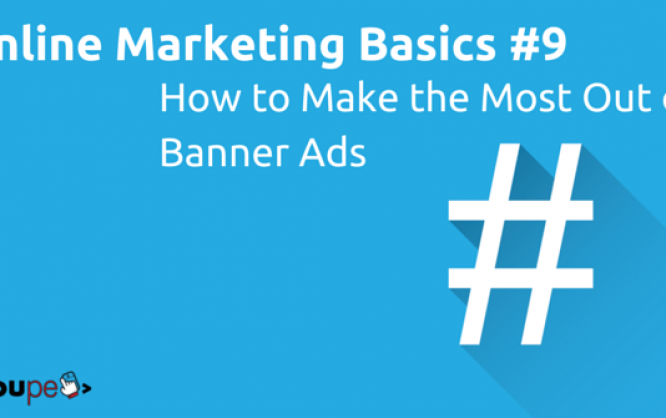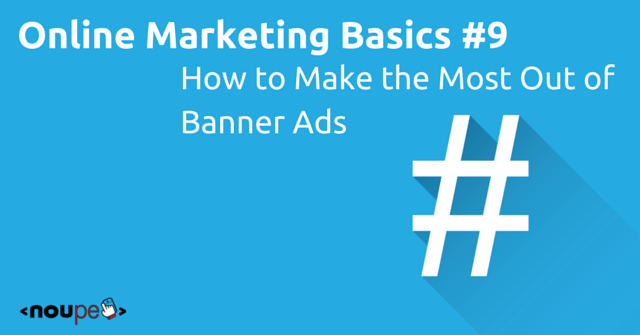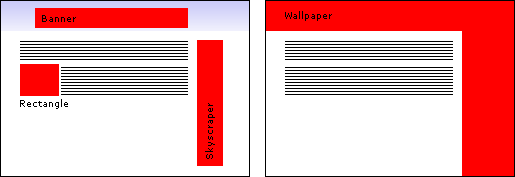Online Marketing Basics #9: How to Make the Most Out of Banner Ads

Banner ads have been around for quite a while. In fact, in internet terms, they have been with us forever, the first ones starting to appear in the mid-90s. Advertising banners are specific areas on a website where ads are placed, just like print ads in a magazine. Clicking on a banner usually takes you to the website of the advertiser. With this post, we will introduce you to this long-serving online marketing tool and discuss how to bring it up to speed with today’s marketing needs.
 Advertising banners have seen their share of criticism for quite some time. Some say many users just ignore all advertising – a phenomenon called banner blindness. Others fear the increasing use of ad blockers would render banner ads obsolete. Both scenarios would lead to click rates hovering around zero. But in spite of all this, banners are still one of the most popular tools of online advertising.
One reason being that there are ways to, at least partly, work around banner blindness and ad blockers to achieve better results. After all, internet giants like Google, Amazon etc. also still use banner advertising, and they are getting results. Net advertising expenditures for online banners reached more than 100 million Euros per month in a market like Germany in 2013 (only three months generated less). In December 2013, the number went up to 136 million Euro (source: OVK Online Report 2014/01).
Display advertising is about more than just banners. The German Federal Association of the Digital Economy’s Online Marketing Group (OVK) uses rather narrowly defined categories like in-stream-video ads and in-page ads.
For the sake of simplicity, I will exclude in-text-advertising from the banner category here, although it’s also an in-page ad type. All other in-page options are kind of similar to a plain banner in how they work: a defined area of the page is being used to put an ad on. Sometimes it’s interactive, sometimes it is displayed in front of the actual website content etc. But eventually, the same rules for success apply to all of these banners.
The Top 10 of online advertising formats in Germany in 2013 is quite telling: three banner ad formats occupied the three top positions. Wallpapers (banners on the top and to the side of a page) came in first with 393 million Euro, followed by the traditional banners with 276 million, and the ad bundle (a combined ad booking of different formats) with 263 million Euro. Seems like reports about the death of the ad banner were exaggerated, in spite of all the doomsayers.
Nevertheless, to let your banner ad campaign be successful and to make sure your hard-earned money is not going down the drain, you still need some basic knowledge, creative banner designs and strategic placements.
Advertising banners have seen their share of criticism for quite some time. Some say many users just ignore all advertising – a phenomenon called banner blindness. Others fear the increasing use of ad blockers would render banner ads obsolete. Both scenarios would lead to click rates hovering around zero. But in spite of all this, banners are still one of the most popular tools of online advertising.
One reason being that there are ways to, at least partly, work around banner blindness and ad blockers to achieve better results. After all, internet giants like Google, Amazon etc. also still use banner advertising, and they are getting results. Net advertising expenditures for online banners reached more than 100 million Euros per month in a market like Germany in 2013 (only three months generated less). In December 2013, the number went up to 136 million Euro (source: OVK Online Report 2014/01).
Display advertising is about more than just banners. The German Federal Association of the Digital Economy’s Online Marketing Group (OVK) uses rather narrowly defined categories like in-stream-video ads and in-page ads.
For the sake of simplicity, I will exclude in-text-advertising from the banner category here, although it’s also an in-page ad type. All other in-page options are kind of similar to a plain banner in how they work: a defined area of the page is being used to put an ad on. Sometimes it’s interactive, sometimes it is displayed in front of the actual website content etc. But eventually, the same rules for success apply to all of these banners.
The Top 10 of online advertising formats in Germany in 2013 is quite telling: three banner ad formats occupied the three top positions. Wallpapers (banners on the top and to the side of a page) came in first with 393 million Euro, followed by the traditional banners with 276 million, and the ad bundle (a combined ad booking of different formats) with 263 million Euro. Seems like reports about the death of the ad banner were exaggerated, in spite of all the doomsayers.
Nevertheless, to let your banner ad campaign be successful and to make sure your hard-earned money is not going down the drain, you still need some basic knowledge, creative banner designs and strategic placements.
 Examples of different banner formats and the special format wallpaper[/caption]
Generally, there are no restrictions regarding the shape or size of a banner ad. Though some industry groups like the aforementioned OVK work to push through standardized online ad formats. For sure, this would make it easier for both advertisers to generate ad banners and website owners to plan, sell, and integrate such banner areas, respectively.
Classic sizes and formats:
Examples of different banner formats and the special format wallpaper[/caption]
Generally, there are no restrictions regarding the shape or size of a banner ad. Though some industry groups like the aforementioned OVK work to push through standardized online ad formats. For sure, this would make it easier for both advertisers to generate ad banners and website owners to plan, sell, and integrate such banner areas, respectively.
Classic sizes and formats:
 Foremost, this, of course, depends on the reputation and reach of the website you want to place your banner at. However, there are several billing models used by most websites regardless of their clout:
Foremost, this, of course, depends on the reputation and reach of the website you want to place your banner at. However, there are several billing models used by most websites regardless of their clout:
 If banner advertising is your preferred online marketing tool you should think strategically about the following 3 key issues:
1. Where will the banner be published?
Where you will place your banners is determind by your target group. The more appealing the publisher website is for your target group, the better the banners will perform there. Like, you wouldn’t promote your ballett shoes online store at a page targeted at soccer fans. In any case though, the website should generate sufficient traffic and be somewhat respectable.
After settling for your favorite publisher websites you should have a closer look at the ad space options. Banners perform best in the upper part of a page, and inside the content section.
2. Does the cost of the banner feel right?
Often it’s kind of difficult to evaluate how much a specific advertising space is actually worth. And how to calculate it varies according to the billing model you choose:
If you pay per action, it’s the most simple. The commission you have to pay to the publisher in case of a purchase should not totally eat up your earnings. If you pay per click you have to know your conversion rate very well, like how many sales do you get from 1,000 clicks and what are your earnings in this case. Again, the costs you will pay have to be lower than your gains.
If you choose to rent a specific ad space on a website or to pay a CPM, this is how you could check if it’s worth financially: Based on a healthy click rate of 0.1 per cent you will get one visitor for every 1,000 ad impressions. Now you can compare the cost for your banner with the one you would have to pay over at Google AdWords. If the former is lower then skip the latter (and stay with the rental or CPM, respectively).
Again, the conversion rate here also reveals a visitor’s value, telling you if the ad generates revenue or not.
3. How should the banner be designed?
But all clever thoughts come to nothing if the banner itself is not properly designed. Because with an unappealing ad your click rates will be in freefall. So here are some basics to keep in mind:
If banner advertising is your preferred online marketing tool you should think strategically about the following 3 key issues:
1. Where will the banner be published?
Where you will place your banners is determind by your target group. The more appealing the publisher website is for your target group, the better the banners will perform there. Like, you wouldn’t promote your ballett shoes online store at a page targeted at soccer fans. In any case though, the website should generate sufficient traffic and be somewhat respectable.
After settling for your favorite publisher websites you should have a closer look at the ad space options. Banners perform best in the upper part of a page, and inside the content section.
2. Does the cost of the banner feel right?
Often it’s kind of difficult to evaluate how much a specific advertising space is actually worth. And how to calculate it varies according to the billing model you choose:
If you pay per action, it’s the most simple. The commission you have to pay to the publisher in case of a purchase should not totally eat up your earnings. If you pay per click you have to know your conversion rate very well, like how many sales do you get from 1,000 clicks and what are your earnings in this case. Again, the costs you will pay have to be lower than your gains.
If you choose to rent a specific ad space on a website or to pay a CPM, this is how you could check if it’s worth financially: Based on a healthy click rate of 0.1 per cent you will get one visitor for every 1,000 ad impressions. Now you can compare the cost for your banner with the one you would have to pay over at Google AdWords. If the former is lower then skip the latter (and stay with the rental or CPM, respectively).
Again, the conversion rate here also reveals a visitor’s value, telling you if the ad generates revenue or not.
3. How should the banner be designed?
But all clever thoughts come to nothing if the banner itself is not properly designed. Because with an unappealing ad your click rates will be in freefall. So here are some basics to keep in mind:
 Advertising banners have seen their share of criticism for quite some time. Some say many users just ignore all advertising – a phenomenon called banner blindness. Others fear the increasing use of ad blockers would render banner ads obsolete. Both scenarios would lead to click rates hovering around zero. But in spite of all this, banners are still one of the most popular tools of online advertising.
One reason being that there are ways to, at least partly, work around banner blindness and ad blockers to achieve better results. After all, internet giants like Google, Amazon etc. also still use banner advertising, and they are getting results. Net advertising expenditures for online banners reached more than 100 million Euros per month in a market like Germany in 2013 (only three months generated less). In December 2013, the number went up to 136 million Euro (source: OVK Online Report 2014/01).
Display advertising is about more than just banners. The German Federal Association of the Digital Economy’s Online Marketing Group (OVK) uses rather narrowly defined categories like in-stream-video ads and in-page ads.
For the sake of simplicity, I will exclude in-text-advertising from the banner category here, although it’s also an in-page ad type. All other in-page options are kind of similar to a plain banner in how they work: a defined area of the page is being used to put an ad on. Sometimes it’s interactive, sometimes it is displayed in front of the actual website content etc. But eventually, the same rules for success apply to all of these banners.
The Top 10 of online advertising formats in Germany in 2013 is quite telling: three banner ad formats occupied the three top positions. Wallpapers (banners on the top and to the side of a page) came in first with 393 million Euro, followed by the traditional banners with 276 million, and the ad bundle (a combined ad booking of different formats) with 263 million Euro. Seems like reports about the death of the ad banner were exaggerated, in spite of all the doomsayers.
Nevertheless, to let your banner ad campaign be successful and to make sure your hard-earned money is not going down the drain, you still need some basic knowledge, creative banner designs and strategic placements.
Advertising banners have seen their share of criticism for quite some time. Some say many users just ignore all advertising – a phenomenon called banner blindness. Others fear the increasing use of ad blockers would render banner ads obsolete. Both scenarios would lead to click rates hovering around zero. But in spite of all this, banners are still one of the most popular tools of online advertising.
One reason being that there are ways to, at least partly, work around banner blindness and ad blockers to achieve better results. After all, internet giants like Google, Amazon etc. also still use banner advertising, and they are getting results. Net advertising expenditures for online banners reached more than 100 million Euros per month in a market like Germany in 2013 (only three months generated less). In December 2013, the number went up to 136 million Euro (source: OVK Online Report 2014/01).
Display advertising is about more than just banners. The German Federal Association of the Digital Economy’s Online Marketing Group (OVK) uses rather narrowly defined categories like in-stream-video ads and in-page ads.
For the sake of simplicity, I will exclude in-text-advertising from the banner category here, although it’s also an in-page ad type. All other in-page options are kind of similar to a plain banner in how they work: a defined area of the page is being used to put an ad on. Sometimes it’s interactive, sometimes it is displayed in front of the actual website content etc. But eventually, the same rules for success apply to all of these banners.
The Top 10 of online advertising formats in Germany in 2013 is quite telling: three banner ad formats occupied the three top positions. Wallpapers (banners on the top and to the side of a page) came in first with 393 million Euro, followed by the traditional banners with 276 million, and the ad bundle (a combined ad booking of different formats) with 263 million Euro. Seems like reports about the death of the ad banner were exaggerated, in spite of all the doomsayers.
Nevertheless, to let your banner ad campaign be successful and to make sure your hard-earned money is not going down the drain, you still need some basic knowledge, creative banner designs and strategic placements.
What Are Typical Banner Formats?
Here we’re not talking about size and alignment, but about banners being animated, being interactive, or having multiple features. These are some formats being used nowadays:- Static banners: plain images without animation
- Combination of image and text: static images with related copy
- Animated banners: a sequence of images or frames evoking a sense of movement
- HTML banners: instead of containing just a graphic design (like static or animated banners), these make use of several HTML elements giving the banner more features
- Nano site banners: a small website the size of a banner, it enables you to integrate more features, even a complete webshop
- Transactive banners: this format communicates with servers. Thus, it’s possible to generate banner content that is dependent from other websites and can be adapted automatically
- Streaming banners: these ones integrate audio and video streams into the banner space
Classic Banner Sizes and Banner Formats
[caption id="attachment_25816" align="alignnone" width="515"] Examples of different banner formats and the special format wallpaper[/caption]
Generally, there are no restrictions regarding the shape or size of a banner ad. Though some industry groups like the aforementioned OVK work to push through standardized online ad formats. For sure, this would make it easier for both advertisers to generate ad banners and website owners to plan, sell, and integrate such banner areas, respectively.
Classic sizes and formats:
Examples of different banner formats and the special format wallpaper[/caption]
Generally, there are no restrictions regarding the shape or size of a banner ad. Though some industry groups like the aforementioned OVK work to push through standardized online ad formats. For sure, this would make it easier for both advertisers to generate ad banners and website owners to plan, sell, and integrate such banner areas, respectively.
Classic sizes and formats:
- Full Banner 468x60 px (gif, jpg, png, flash)
- Super Banner 728x90 px (gif, jpg, png, flash)
- Expandable Super Banner 728x300 (90) px (gif, jpg, png, flash)
- Rectangle 180x150 px (gif, jpg, png, flash)
- Medium Rectangle 300x250 px (gif, jpg, png, flash)
- Standard Skyscraper 120x600 px (gif, jpg, png, flash)
- Wide Skyscraper 160/200x600 px (gif, jpg, png, flash)
- Expandable Skyscraper 420(160)x600 px (gif, jpg, png, flash)
- Universal Flash Layer 400x400 px (flash)
- Flash Layer individual (flash)
- Button max. 234x60 px (gif, jpg, png, flash)
- Ad Bundle customized (gif, jpg, flash)
What’s a Banner Worth?
When doing online marketing your goal is to direct visitors to a specific web presence, most of the time it’s your own website. The same applies to any banner ad campaign of course. So no matter what format you choose (static, animated, nano website etc.), eventually you want users to interact with your website in some way: subscribe to a newsletter, do a purchase etc. The metric telling you how successful your banner ad actually performed this task is called conversion rate. Besides pushing sales a banner campaign could also be used to build brand awareness. Because even if users don’t interact directly with a banner they still get to see your ad thereby generating banner impressions and possibly increasing awareness for your brand.How Much is a Banner?
 Foremost, this, of course, depends on the reputation and reach of the website you want to place your banner at. However, there are several billing models used by most websites regardless of their clout:
Foremost, this, of course, depends on the reputation and reach of the website you want to place your banner at. However, there are several billing models used by most websites regardless of their clout:
- Fixed amount: This flat charge is like the rent for a specific ad space on the website. The banner is displayed each time someone views the page. With this model it doesn’t matter how many impressions or clicks are generated. So the advertiser should thoroughly check the site’s metrics beforehand.
- Cost per Thousand (CPM): This is the price you have to pay for 1,000 ad impressions. If a publisher charges a CPM of $5, the advertiser has to pay $500 for 100,000 impressionsaccording to a CPM calculator. A so-called frequency cap prevents the banner from being displayed to the same user again and again in a short period of time, using up all your purchased impressions. This way, the publisher makes sure your impressions reach a wider audience.
- Cost per Click (CPC): When you use a cost per click (or sometimes Pay per click: PPC) model you only pay if a user actually clicks on your banner ad. So the advertiser benefits twice: they only have to pay if users really interacted with the ad, and they get the brand awareness generated by every impression on top.
- Cost per Action (CPA): With a cost per action model the advertiser only pays if users not just click on the banner ad, and visit the advertiser’s website afterwards, but also carry out a predefined action on this website. These include purchasing something, subscribing to a newsletter, sharing some contact details etc. Again, the generated brand awareness is a welcome side effect here, at no extra cost.
What Makes a Banner Perform Well?
 If banner advertising is your preferred online marketing tool you should think strategically about the following 3 key issues:
1. Where will the banner be published?
Where you will place your banners is determind by your target group. The more appealing the publisher website is for your target group, the better the banners will perform there. Like, you wouldn’t promote your ballett shoes online store at a page targeted at soccer fans. In any case though, the website should generate sufficient traffic and be somewhat respectable.
After settling for your favorite publisher websites you should have a closer look at the ad space options. Banners perform best in the upper part of a page, and inside the content section.
2. Does the cost of the banner feel right?
Often it’s kind of difficult to evaluate how much a specific advertising space is actually worth. And how to calculate it varies according to the billing model you choose:
If you pay per action, it’s the most simple. The commission you have to pay to the publisher in case of a purchase should not totally eat up your earnings. If you pay per click you have to know your conversion rate very well, like how many sales do you get from 1,000 clicks and what are your earnings in this case. Again, the costs you will pay have to be lower than your gains.
If you choose to rent a specific ad space on a website or to pay a CPM, this is how you could check if it’s worth financially: Based on a healthy click rate of 0.1 per cent you will get one visitor for every 1,000 ad impressions. Now you can compare the cost for your banner with the one you would have to pay over at Google AdWords. If the former is lower then skip the latter (and stay with the rental or CPM, respectively).
Again, the conversion rate here also reveals a visitor’s value, telling you if the ad generates revenue or not.
3. How should the banner be designed?
But all clever thoughts come to nothing if the banner itself is not properly designed. Because with an unappealing ad your click rates will be in freefall. So here are some basics to keep in mind:
If banner advertising is your preferred online marketing tool you should think strategically about the following 3 key issues:
1. Where will the banner be published?
Where you will place your banners is determind by your target group. The more appealing the publisher website is for your target group, the better the banners will perform there. Like, you wouldn’t promote your ballett shoes online store at a page targeted at soccer fans. In any case though, the website should generate sufficient traffic and be somewhat respectable.
After settling for your favorite publisher websites you should have a closer look at the ad space options. Banners perform best in the upper part of a page, and inside the content section.
2. Does the cost of the banner feel right?
Often it’s kind of difficult to evaluate how much a specific advertising space is actually worth. And how to calculate it varies according to the billing model you choose:
If you pay per action, it’s the most simple. The commission you have to pay to the publisher in case of a purchase should not totally eat up your earnings. If you pay per click you have to know your conversion rate very well, like how many sales do you get from 1,000 clicks and what are your earnings in this case. Again, the costs you will pay have to be lower than your gains.
If you choose to rent a specific ad space on a website or to pay a CPM, this is how you could check if it’s worth financially: Based on a healthy click rate of 0.1 per cent you will get one visitor for every 1,000 ad impressions. Now you can compare the cost for your banner with the one you would have to pay over at Google AdWords. If the former is lower then skip the latter (and stay with the rental or CPM, respectively).
Again, the conversion rate here also reveals a visitor’s value, telling you if the ad generates revenue or not.
3. How should the banner be designed?
But all clever thoughts come to nothing if the banner itself is not properly designed. Because with an unappealing ad your click rates will be in freefall. So here are some basics to keep in mind:
- Adapt the banner to the publisher website. A grey banner will not stick out on a grey page. Dare to stand out.
- Animations draw attention. But don’t overdo it. You don’t want to put off your target group.
- Don’t forget a call-to-action. You want users to interact. Telling them to do something increases your chances.
- Address a need. Online marketing is about content, convey your message short and simple, in a way that directly reaches your target group.

Great post. Having read this I thought it was very informative. I appreciate you taking the time and energy to put this content together. I once again find myself spending a significant amount of time both reading and leaving comment. But so what, it was still worthwhile. Thanks for sharing.
Really helpful post. Specially the banner size you have explained, it was a really important thing for me. Thanks for writing.